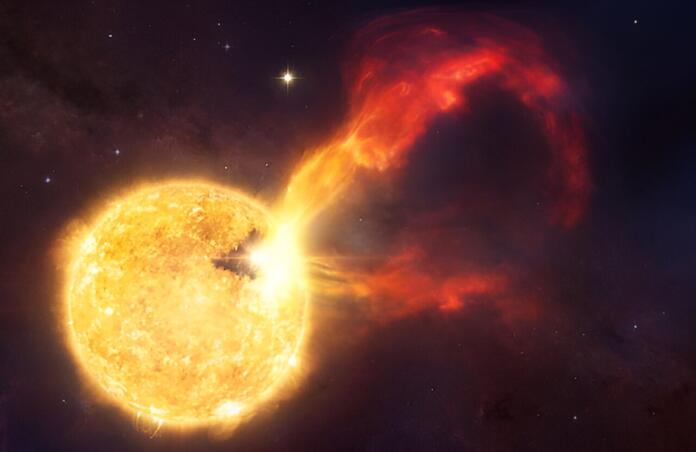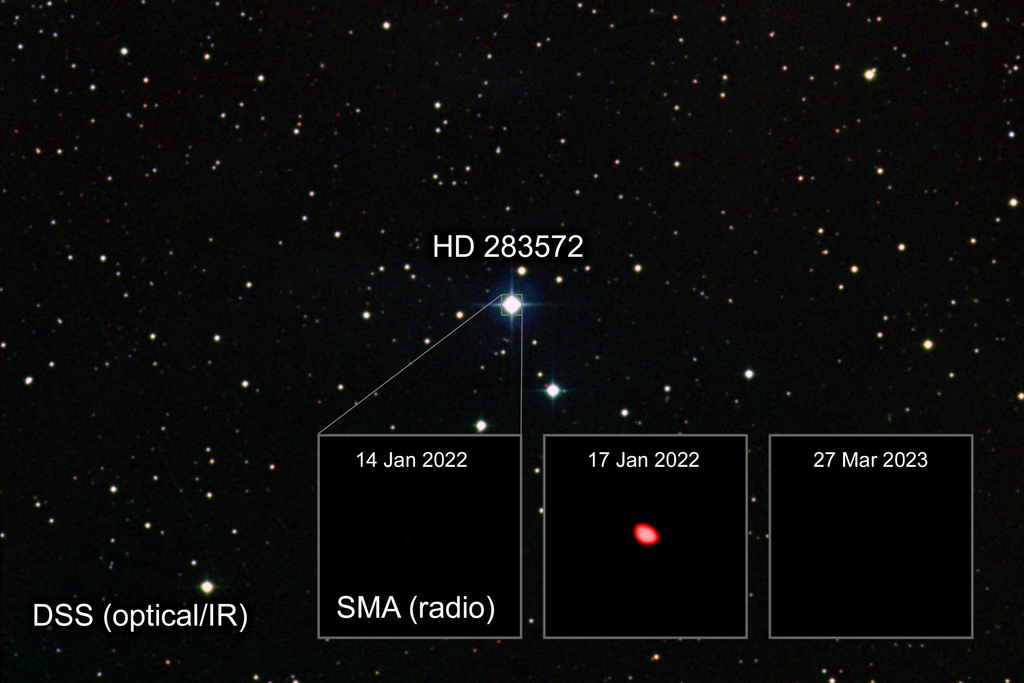Detection of powerful flare from young star reveals glance into early exoplanet development

A team of researchers at the Smithsonian Astrophysical Observatory part of the centre for Astrophysics | Harvard & Smithsonian have detected an extremely powerful eruption from a young star. The vast flare, which caused the star to brighten by a factor of over 100 in the 9-hour event, can provide important insight into the behaviour of young sun-like stars and their effects on the planets which are forming around them.
The star named HD 283572 is located around 400 light years away and is 40% more massive than the sun. Additionally, it is less than 3 million years old, making it over 1000 times younger than our sun. At this age, earth-like planets begin to form around such stars. The team used observations of HD 283572 taken with the Submillimeter Array (SMA), a group of telescopes on Mauna Kea, Hawaii designed to detect millimeter wavelength light. The objective was to search for the dusty material produced in the formation of young planets, since this gives off faint but detectable emission at millimeter or radio wavelengths. However, something completely different was found – a stellar flare.

“We were surprised to see an extraordinarily bright flare from an ordinary young star," said Dr. Joshua Bennett Lovell, an SAO astronomer and SMA fellow at CfA. "Flares at these wavelengths are rare, and we had not anticipated seeing anything but the faint glow of planet-forming dust." A star’s brightness at different wavelengths can be amplified by factors of tens or hundreds by a flaring event. As a star rotates, it winds up its magnetic field which results in the development of regions which have higher magnetic energy. This built-up energy is then released through the intense acceleration of charged particles which break through the stars surface.
The main challenge for observing these explosive events is that it is fairly hard to predict when a star might flare next, therefore catching such events at millimeter wavelengths is particularly difficult. "HD 283572 appeared dormant for months before we caught its eruption," said Lovell. "Every time we pointed the SMA back at the star after this flare, we saw nothing. Our findings confirm that these flare events are rare at millimeter wavelengths but that these can be extremely powerful for stars at this young age."
Over the 9-hour period, the flaring event released around a million times more energy than any millimeter flares seen on the sun’s closest neighbours. This makes it one of the most powerful reported flares of its kind. However, it still remains unclear as to what activated the event, since only one flare was detected. "It's a real puzzle, and there are a range of mechanisms that could be at play. Interactions with unseen companion stars or planets or periodic starspot activity are two possibilities, but what remains beyond doubt is how powerful an event this was," said Dr Garrett Keating, second author on the study and SMA project scientist. "Any potential planets developing in this system would have been hammered by the intense power of this flare. I wouldn't want to grow up there!"
Important clues from the star such as its young age and sun-like nature can give insight into the typical environments that a developing earth-like planet may experience. Such powerful flares can restrict the growth of a planets’ atmosphere or severely damage it.
Currently, the team are carrying out further observations to better understand the frequency of HD 283572’s flaring activity, and whether flares on young stars can limit the growth of planetary atmospheres.
--
Cover image: CfA/Melissa Weiss
Journal source: Joshua Bennett Lovell et al, SMA Detection of an Extreme Millimeter Flare from the Young Class III Star HD 283572, The Astrophysical Journal Letters (2024). DOI: 10.3847/2041-8213/ad18ba
